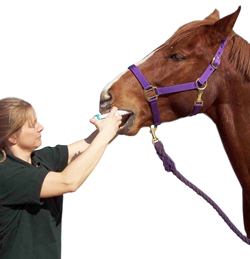Of the many dozens of internal parasites that can infect horses, only a few parasite species are capable of any serious harm. The top four are associated with the greatest health threats; the others are in alphabetic order:

Large strongyles (Strongylus spp.), also called bloodworms, migrate as larvae through the abdominal arteries, causing damage that can lead to rupture or circulation blockages. Some species damage the liver and other internal organs. Effects range from weight loss and anemia to fatal colics.
Small strongyles (cyathostomes) burrow into the intestinal wall as larvae and encyst. Signs of infection include weight loss and failure to thrive; large numbers of small strongyles emerging at once can cause diarrhea and weight loss, and, rarely, death may result.
Ascarids (Parascaris equorum) are intestinal worms typically found in foals. Ascarids may cause weight loss, diarrhea and/or colic. Immunity develops with maturity.
Tapeworms (cestodes) can cause colic and contribute to intestinal blockage. Three species of tapeworms affect horses; their larvae mature in the equine intestinal tract within four to six weeks after the eggs are ingested and then shed egg-bearing segments in the manure.
Botflies (Gasterophilus spp.) lay tiny yellow eggs usually on the hairs of a horse’s front legs. The larvae enter the mouth when the horse licks at them, then become attached to the stomach wall, where they develop into grubs that pass out through the feces.
Eye worms (Thelazia lacrymalis) live in the tear ducts. Excess tearing may be the only sign of eye worms, but light sensitivity or conjunctivitis and related infections may also occur.
Filarids (Onchocerca spp.) are thin, small worms transmitted by biting flies. They live in the neck ligaments and skin tissues, causing a maddeningly itchy immune reaction in some horses. The larvae can also invade the eye.
Lungworms (Dictyocaulus arnfieldi) are most common in donkeys and mules, but horses pastured with them may become infected. The larvae migrate through the intestinal wall and into the lungs, where they become egg-laying adults. Chronic cough may be a sign of infection.
Pinworms (Oxyuris equi) damage the bowel wall during their larval stage, but the tip-off to infection is usually the tail itching incited by the female laying her eggs in the anal area. As horses mature, they seem to develop immunity to pinworms.
Stomach worms (Habronema muscae), transmitted by flies, are responsible for summer sore. The larvae reside in open sores, causing inflammation and chronic wounds or lesions.
Threadworms (Strongyloides westeri) are usually the first parasites to infect foals. They may cause diarrhea, but immunity usually develops before young-sters are weaned.








